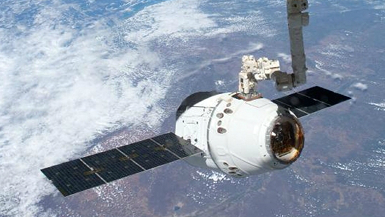That “NewSpace Moment”: Silicon Valley Redux

The recent berthing of SpaceX’s (NSG 100: SET; #1) Dragon capsule at the International Space Station (ISS) changed history by becoming the first commercial spacecraft to successfully berth with the ISS. NSG analysts have extensively written in Thrusterthat the event will catalyze the growth of the NewSpace (commercial space) sector. So do the early-to-mid stage investors who view this type of catalyzing as the driving force behind an industry’s growth and long-term viability. It has occurred many times in industries familiar to contemporary investors.
The SpaceX Dragon capsule moments before it berths with the International Space Station on May 31 (Photo courtesy of NASA)
In the mid-1990s, the Internet industry experienced a game-changing event that analysts commonly refer to as the “Netscape Moment.” The creation of Netscape Navigator, followed by Netscape’s IPO in August 1995, is usually viewed as the beginning of an inflection point that resulted in a drastic increase in investment and subsequent growth in the Internet sector. Netscape enjoyed a market capitalization of $2.9 billion on its first trading day, and its revenues doubled every few months during that period. As the number of Web users increased, the entire Internet ecosystem grew in tandem. From fall 1995 through the end of 1996, Internet investment increased drastically.
Several members in Space Angels Network, a group of accredited angels that invests in aerospace and aviation startups, have faith that a comparable event will occur in NewSpace. The recent SpaceX success serves quite nicely as the precursor to an upcoming Netscape Moment for commercial space. Especially if you consider the strong similarities between the NewSpace and Internet industries coupled with the high number of entrepreneurs and venture capitalists keeping one foot persistently in each industry. (Please see “Investor Watch” by NSG Analysts and Ian Fichtenbaum in the May 2012 issue of Thruster.)
In general, there are two major types of Internet companies: those that specialize in infrastructure and those devoted to applications. Cisco (NSG PTC: CSCO), Juniper Networks, and Intel are examples of infrastructure companies. They make the stuff that the Internet runs on: nodes, servers, switches, routers, chips, etc. Application companies like Facebook, Google (NSG PTC: GOOG), eBay, and Amazon (NSG PTC: AMZN) use the infrastructure to generate revenues. Without infrastructure, the Internet could not exist. Neither could its applications.
This same structure exists in the space industry. Infrastructure companies build the stuff to get things into space, and application companies derive value from these space assets. SpaceX (NSG 100: SET; #1) and Virgin Galactic (NSG 100: VG; #5) are building the infrastructure to get things to space. Direct TV (NSG PTC: DTV), Digital Globe (NSG PTC: DTV), ABS (NSG 100; ABS; #12), Skybox Imaging (NSG 100: SKYB; #3) and Nanoracks (NSG 100: NANO; #8) use the space industry’s infrastructure to generate data and services for their customers.
Interestingly, application companies generally have a higher perceived value in the public markets than infrastructure companies; it’s evident in both the NewSpace and Internet industries. For example, although Cisco has more employees, has been around longer, and has more annual revenues than Google, it has a lower market cap and price-earnings (P/E) ratio—$91.6 billion and a P/E of 12.63 versus $184 billion and a P/E of 17.1. This is a good sign for the NewSpace industry, which is in the early stages of application development.
Contrary to Internet folklore, Al Gore didn’t create the Internet. It was created through a coordinated government effort between the Department of Defense and various universities. Government spending provided the foundation for the Internet and commercial investment and companies built it into the vast, society-transforming industry it is today.
Similarly, government spending through NASA has created a foundation on which commercial enterprise can capitalize. That spending totals about $800 billion (adjusting for inflation) over the 50-plus year existence of the agency. Hardware, intellectual property, and raw data—predominately created by NASA—are now being leveraged by NewSpace companies like those found on the NSG 100, an index of the top 100 privately-traded companies in the sector. In addition, NASA continues to support the commercialization of space by offering contracts, grants, and other assistance to help fuel the NewSpace industry. (Please see “Escape Velocity/Exit Strategy” by Dick Rocket in the May 2012 issue of Thruster.)
Is today’s NewSpace industry where the Internet industry was in 1994? Could SpaceX’s successful docking with the ISS be a Netscape or NewSpace Moment? Only time will tell, but NSG analysts contend it may very well be.





